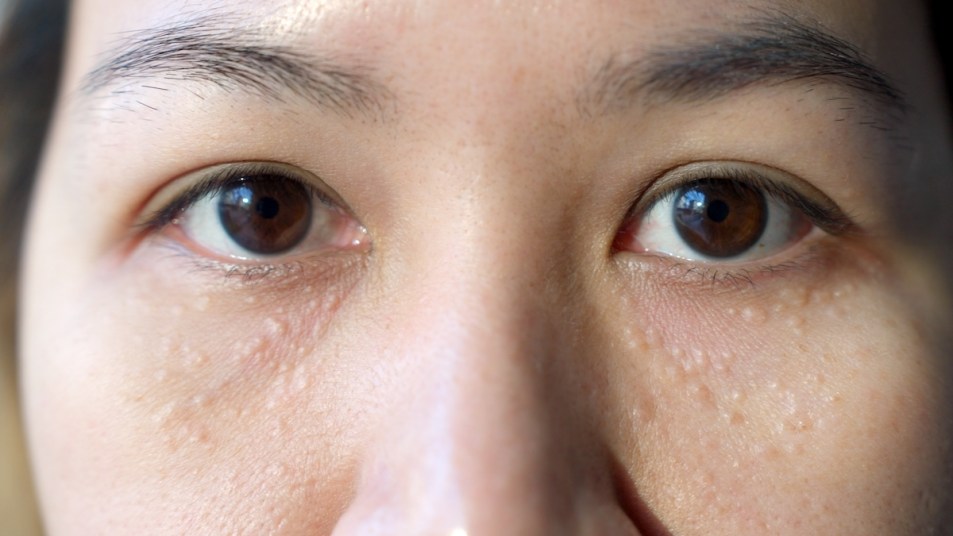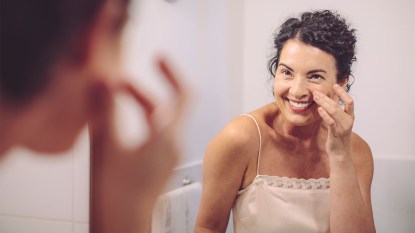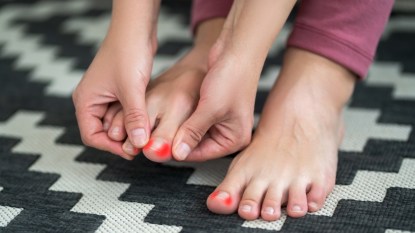What Causes Milia (AKA Milk Spots) — And How Can You Safely Treat Them at Home?
These pesky bumps are a common concern.

Let’s talk milia (also known as milk spots). If you’re not familiar, these are the tiny white bumps that can appear around the eyes and on other parts of the face in babies, and virtually anywhere on older adults. A type of cyst caused by the accumulation of keratin beneath the surface of the skin, milia are often mistaken for pimples or clogged pores. Treating milia, however, requires a different approach than the one used to treat acne. Below are the causes of milia and tips for safe milia treatment at home.
What should I know about milia?
Milia or “milk spots” are caused by the buildup of dead skin cells, oil, and debris that get trapped in your pores. Unlike acne, milia are not inflammation-based. This means they’re not caused by bacteria or other irritants. They’re simply keratin-filled cysts that form under the skin’s surface. Unlike some other skin conditions, these little bumps typically don’t itch, ooze, smell bad, or feel painful.
How common are milia?
Milia are quite common, especially in newborns, those with fair skin, and those who are frequently exposed to the sun. For the former, milia tends to go away on its own within a few weeks. For adults, milia tend to be more persistent, though they typically respond well to treatments.
What causes milia to flare up?
Milia can appear due to many reasons, including:
Genetics
Genetics can play a role in whether or not you’re prone to developing milia. Research has found that people with a family history of milia are more likely to experience it themselves.
Skincare Products
The skincare products you use could also cause milia to appear. Products that are too heavy or thick, such as rich creams and oils, can trap dead skin cells and oil underneath the surface of your skin. This can lead to the formation of milia.
Sun Damage
UV radiation from the sun can damage the skin, causing the development of milia. Sun damage can thicken the skin, making it harder for dead skin cells to shed naturally.
Hormonal Changes
Hormonal changes can also play a role in the formation of milia. This is particularly true for women who experience increased androgens, which can cause the skin to produce more oil.
Poor Exfoliation
Exfoliation helps remove dead skin cells and prevent build-up. Exfoliate regularly as part of your skincare routine to avoid accumulation of the dead skin cells on the surface of your skin that prompt milia.
Medical Conditions and Treatments
In some cases, milia can be a symptom of an underlying medical condition or a medication side effect. For instance, if you have a skin disorder, such as rosacea or eczema, or if you’re undergoing chemotherapy or surgery, you may experience milia.
Trauma and Injury
Finally, milia can appear as a result of trauma or injury to the skin, such as burns, blisters, or acne. When the skin is injured, it may produce excess keratin, a protein that forms the outermost layer of the skin and hair, which can clog the pores and cause milia.
What’s the best way to treat milia?
Below are nine tips for treating a milia skin condition at home.
1. Don’t pick or scratch milia.
The first and perhaps most important tip for treating milia is to resist the urge to pick or scratch them. Doing so can cause scarring and infection or make them worse. Instead, stick to gentle treatments that encourage the skin to exfoliate naturally.
2. Use facial exfoliants.
Facial exfoliants are an excellent way to remove the build-up of dead skin cells, oil, debris, and trapped dirt that can cause milia to form. You may choose to invest in a gentle scrub or chemical exfoliant that can dissolve dead skin and promote cell turnover.
3. Avoid heavy skincare products.
Steer clear of harsh chemical-laden moisturizers and makeup formulated with ingredients known to cause acne. Instead, opt for organic skincare products like jojoba oil, argan oil, or rosehip seed oil, which are light and airy.
4. Use retinoids.
Retinoids come from vitamin A and can help with a variety of skin concerns — including milia, in some cases. It helps eliminate dead skin cells, promotes cell turnover to lessen milia formation, and keeps your skin smooth and even-toned. You can find topical retinoid creams, solutions, and serums at your local drugstore. However, they may not be ideal for individuals with highly sensitive skin types, as they can cause dryness and irritation.
5. Try topical creams.
Topical creams can help treat milia if they contain active ingredients like alpha hydroxy acids (AHAs). These ingredients work to soften the skin and reduce irritation, promoting healthy cell turnover and reducing the occurrence of milia.
6. Use a warm compress.
A warm compress may help soothe milia by softening the affected area. The warmth of the compress helps in the buildup of pus, thus helping the milia to “pop out.” To make your warm compress, dip a washcloth in warm water and let it sit on the affected area for three to four minutes.
7. Try a chemical peel.
Chemical peels are often effective when treating milia. They help loosen the dead skin cells and dirt, allowing the milia to come out. You can find over-the-counter chemical peels with ingredients like glycolic acid, lactic acid, and salicylic acid. Still, it’s smart to consult a dermatologist for advice when starting a new treatment.
8. Invest in a good sunscreen.
Protecting your skin from the sun is important to prevent milia and generally avoid damaging your skin in the long run. Choose a broad-spectrum sunscreen with high SPF content that offers UVA and UVB protection. Make sure to apply it every day, even when the weather is cloudy or cool.
9. Visit a dermatologist.
If your milia persists or worsens after trying the aforementioned remedies, it’s best to seek professional help. A board-certified dermatologist can recommend treatments such as laser therapy, cryotherapy, or steroid injections to help you get rid of milia. For smaller breakouts, they can also simply use a sterile needle or comedone extractor for easy milia removal.
Any advice on how to prevent milia?
Prevention is key when it comes to milia. Here are tips for keeping these tiny bumps at bay:
Cleanse your skin properly and often.
Proper cleansing is crucial to prevent milia. Make sure to remove all makeup and dirt from your face before going to bed. Use a gentle cleanser and massage it in with gentle circular motions, rinsing thoroughly with lukewarm water. Avoid using hot water, which can strip your skin of its natural oils and cause dryness.
Stay hydrated.
Drinking plenty of water is essential for preventing milia. When your skin is dehydrated, it can become dry, flaky, and prone to milia. Make sure to drink at least eight glasses of water per day to keep your skin hydrated and healthy. You can also incorporate hydrating foods into your diet, such as watermelon, cucumbers, and tomatoes.
Moisturize daily.
Using a light moisturizer every day is essential in milia prevention. Choose one that’s suited to your skin type and packed with hydrating ingredients like hyaluronic acid or glycerin. Apply it to your face morning, night, and whenever your skin feels dry.
When should I seek medical attention?
If you’ve tried self-care treatments at home and have seen no improvement after several months, it’s time to visit a dermatologist. Additionally, if you find that milia are spreading or new spots are appearing, seek medical help. Do the same if you have cysts or boils that are red, swollen, and painful. These may be signs of an infection, and they need to be treated by a professional.
Key Takeaways
Milia can be frustrating to deal with, but understanding why they appear can help you better prevent and treat them. Whether it’s limiting your sun exposure, using non-comedogenic products, or being aware of hormonal changes, there are steps you can take to keep your skin looking its best. Don’t be afraid, too, to get advice from a skincare professional. With the right care, you can achieve the healthy, clear skin of your dreams.













